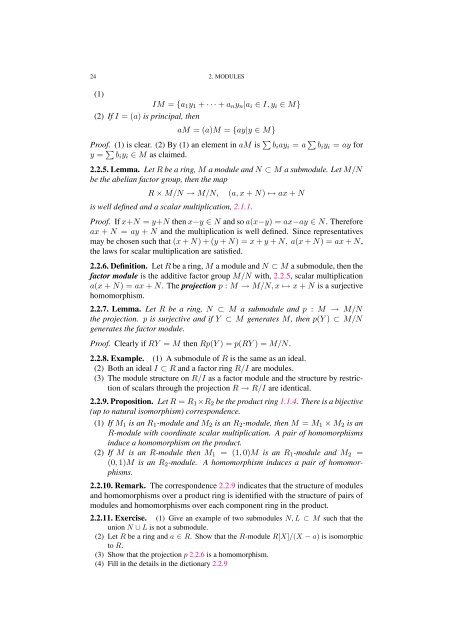Commutative algebra - Department of Mathematical Sciences - old ...
Commutative algebra - Department of Mathematical Sciences - old ...
Commutative algebra - Department of Mathematical Sciences - old ...
You also want an ePaper? Increase the reach of your titles
YUMPU automatically turns print PDFs into web optimized ePapers that Google loves.
24 2. MODULES<br />
(1)<br />
IM = {a1y1 + · · · + anyn|ai ∈ I, yi ∈ M}<br />
(2) If I = (a) is principal, then<br />
aM = (a)M = {ay|y ∈ M}<br />
Pro<strong>of</strong>. (1) is clear. (2) By (1) an element in aM is biayi = a biyi = ay for<br />
y = biyi ∈ M as claimed.<br />
2.2.5. Lemma. Let R be a ring, M a module and N ⊂ M a submodule. Let M/N<br />
be the abelian factor group, then the map<br />
R × M/N → M/N, (a, x + N) ↦→ ax + N<br />
is well defined and a scalar multiplication, 2.1.1.<br />
Pro<strong>of</strong>. If x+N = y+N then x−y ∈ N and so a(x−y) = ax−ay ∈ N. Therefore<br />
ax + N = ay + N and the multiplication is well defined. Since representatives<br />
may be chosen such that (x + N) + (y + N) = x + y + N, a(x + N) = ax + N,<br />
the laws for scalar multiplication are satisfied.<br />
2.2.6. Definition. Let R be a ring, M a module and N ⊂ M a submodule, then the<br />
factor module is the additive factor group M/N with, 2.2.5, scalar multiplication<br />
a(x + N) = ax + N. The projection p : M → M/N, x ↦→ x + N is a surjective<br />
homomorphism.<br />
2.2.7. Lemma. Let R be a ring, N ⊂ M a submodule and p : M → M/N<br />
the projection. p is surjective and if Y ⊂ M generates M, then p(Y ) ⊂ M/N<br />
generates the factor module.<br />
Pro<strong>of</strong>. Clearly if RY = M then Rp(Y ) = p(RY ) = M/N.<br />
2.2.8. Example. (1) A submodule <strong>of</strong> R is the same as an ideal.<br />
(2) Both an ideal I ⊂ R and a factor ring R/I are modules.<br />
(3) The module structure on R/I as a factor module and the structure by restriction<br />
<strong>of</strong> scalars through the projection R → R/I are identical.<br />
2.2.9. Proposition. Let R = R1×R2 be the product ring 1.1.4. There is a bijective<br />
(up to natural isomorphism) correspondence.<br />
(1) If M1 is an R1-module and M2 is an R2-module, then M = M1 × M2 is an<br />
R-module with coordinate scalar multiplication. A pair <strong>of</strong> homomorphisms<br />
induce a homomorphism on the product.<br />
(2) If M is an R-module then M1 = (1, 0)M is an R1-module and M2 =<br />
(0, 1)M is an R2-module. A homomorphism induces a pair <strong>of</strong> homomorphisms.<br />
2.2.10. Remark. The correspondence 2.2.9 indicates that the structure <strong>of</strong> modules<br />
and homomorphisms over a product ring is identified with the structure <strong>of</strong> pairs <strong>of</strong><br />
modules and homomorphisms over each component ring in the product.<br />
2.2.11. Exercise. (1) Give an example <strong>of</strong> two submodules N, L ⊂ M such that the<br />
union N ∪ L is not a submodule.<br />
(2) Let R be a ring and a ∈ R. Show that the R-module R[X]/(X − a) is isomorphic<br />
to R.<br />
(3) Show that the projection p 2.2.6 is a homomorphism.<br />
(4) Fill in the details in the dictionary 2.2.9
















